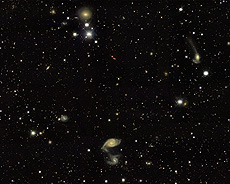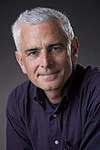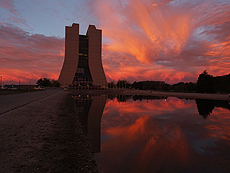Have a safe day!
Wednesday, Oct. 15
3:30 p.m.
Director's Coffee Break - WH2XO
4 p.m.
Fermilab Colloquium - One West
Speaker: Michael Lubell, American Physical Society, City College of New York
Title: From the Physics Trenches to the Political Swamp
Thursday, Oct. 16
2:30 p.m.
Theoretical Physics Seminar - Curia II
Speaker: Seyda Ipek, University of Washington
Title: CP Violation in Pseudo-Dirac Fermion Oscillations
3:30 p.m.
Director's Coffee Break - WH2XO
Visit the labwide calendar to view Fermilab events
|
|
Wednesday, Oct. 15
- Breakfast: breakfast strata
- Breakfast: ham, egg and cheese English muffin
- Carolina pulled pork sandwich
- Chicken vincenza with pasta
- Shepherd's pie
- Ham and pear panino
- Grilled or crispy chicken Caesar salad
- Sausage, potato and kale soup
- Texas-style chili
- Assorted calzones
Wilson Hall Cafe menu |
|
Wednesday, Oct. 15
Lunch
- Orange glazed pork tenderloin
- Cranberry tabbouleh
- Snap pea sauté
- Apple crisp
Friday, Oct. 17
Dinner
Closed
Chez Leon menu
Call x3524 to make your reservation.
|
|
Accepting Wilson Fellowship applications through Nov. 14
The Wilson Fellowship at Fermilab seeks applications from Ph.D.
physicists of exceptional talent with at least two years of
postdoctoral experience.
The fellowship is awarded on a competitive
basis and is intended to support strong, assistant professor-level
physicists early in their careers. It provides unique opportunities for
self-directed research in experimental physics through work on the
Fermilab particle physics experiment of the candidate's choice. The
Fermilab experimental program includes collider physics, studies of
neutrino, muon and astroparticle physics, as well as R&D and planning
for experiments at future colliders and high-intensity beams.
The Wilson Fellowship provides an annual salary fully competitive with a
university assistant professorship. The appointment is for an initial
term of three years, and there exists the possibility for renewal for
an additional two years upon completion of a successful review after
the first two years. Thereafter, the potential exists for eventual
appointment without term limit.
Each candidate should submit a curriculum vitae and a research statement
(not to exceed five pages) giving a focused description of his or her
proposed research program as a Wilson fellow. The applicant should arrange to have
four letters of reference submitted online.
The application deadline is Friday, Nov. 14.
Additional information is available at the Wilson Fellowship Web page. Questions may be submitted via email to wilson_fellowship@fnal.gov.
|
Tributaries of time: autumn leaves
 |
| Each puff of light in a dusty swirl pictured here contains billions of stars. Through our telescopes, images and spectrographs, we learn about the kinds of matter that reside within galaxies. Photo: Dark Energy Survey |
Across North America, as the transition toward winter begins, we see symptoms in the changing colors of tree leaves. The lively green hue of summer gives way to yellows, oranges, reds and purples. Living cells inside the leaves have instructions for how to react to cooler and cooler environments: this reaction reduces the production of the green pigment, chlorophyll, allowing other colors (caused by the pigments of the carotenoids and anthocyanins) to dominate. When spring returns, so do leaves, newly filled with oxygen-producing chlorophyll.
Year after year, we watch the cycle of death and rebirth in the life-giving foliage around us.
But what if we were insects? What if, like the mayfly, we lived for only a day or two? Would we have any way of understanding the immense tapestry evolving around us? Imagine for one day on Earth, looking at leaves all over the globe — in different environments and in various states of health and age. With just this one day to create a coherent picture, could we piece together the clues of color, environment and the internal workings?
This is the challenge we face in understanding the life-cycle of galaxies, the leaves on our cosmic tree of matter and light. To these celestial objects, we are indeed the mayfly, living for only a blink of an eye in cosmic time.
Read more
—Brian Nord
|
Are we closer to solving the meaning of LIFE? World's longest neutrino beam seeks to find out why our universe exists
From Daily Mail, Oct. 14, 2014
The world's longest neutrino experiment has begun its probe into the mysteries of 'ghostly' particles that may hold the key to understanding the universe.
The machine, called Nova, is made up of two huge detectors — placed 500 miles (800km) apart — to study one of nature's most elusive subatomic particles.
Scientists believe that a better understanding of neutrinos, one of the most abundant and difficult-to-study particles, may lead to a clearer picture of the inner workings of the universe.
Read more
|
Synopsis: Discriminating dark matter from neutrinos
From Physics, Oct. 7, 2014
Several experiments across the globe are poised to detect the possible sign of a dark matter particle colliding with a nucleus. These dark matter searches can also potentially record collisions of neutrinos from the Sun and other astrophysical sources. This neutrino background could become a confounding factor in next-generation dark matter experiments. But a new theoretical analysis by Julien Billard of the Massachusetts Institute of Technology, Cambridge, and his colleagues suggests how to discriminate signals from neutrinos and dark matter by using multiple types of detector materials.
Read more
|
|
Big eyes
 |
|
Craig Hogan
|
Craig Hogan, head of the Center for Particle Astrophysics, wrote this column.
To create small things you need particles with lots of energy, and to learn about them you need to capture and study lots of particles. So it is not surprising that the worldwide physics community is in the business of building giant accelerators and detectors.
We also find out about new physics without using accelerators by studying the biggest system of all — the cosmos. Such experiments also need big detectors, in particular, giant cameras to make deep, wide-field maps of cosmic structure.
For example, Fermilab's Dark Energy Camera (DECam) is now collecting data for the Dark Energy Survey, using light from distant galaxies gathered by the 4-meter Blanco telescope on Cerro Tololo in Chile. Designed for depth, speed, sensitivity and scientific precision, it's a behemoth compared to the camera in your phone. By the time you add up all the parts — the detectors, the lenses, the cooling systems, the electronics and the structure to hold them precisely in place 50 feet up in the telescope beam — you have a machine that weighs about 10 tons. That may not seem very big compared to the Tevatron or the thousand-ton telescope the camera is mounted on, but it's a lot for a digital camera — the biggest ever built.
The giant telescope simulator used to test DECam has recently been removed from the Fermilab building where the camera was put together. In the same space, another giant camera will soon start to take shape. This one will study the cosmic microwave background — the primordial light from the big bang. That light has been cooled by the cosmic expansion to microwave wavelengths, so the camera detectors and even its lenses must be cold to match. About 15,000 advanced superconducting detectors from Argonne National Laboratory will be integrated into a camera system about as big as DECam and then shipped for an experiment to take place under the thin, cold, crystalline skies at the South Pole.
This machine — the SPT-3G camera — will also be the largest of its kind ever built. When it is finished, it will be installed on the South Pole Telescope, where it will map the faint ripples of polarization imprinted on the light since it was created almost 14 billion years ago.
The SPT-3G experiment will advance cosmic mapping by an order of magnitude, but it is also a stepping stone along a path to an even larger Stage 4 CMB project in the following decade. That project, endorsed by the P5 report and supported by a nationwide collaboration of labs and university groups now forming, will carry out a comprehensive survey of the primordial radiation over much of the sky and teach us about new physics ranging from neutrino masses to dark energy.
|
Aurora redshift?
 |
| Gorgeous, red-orange clouds over Wilson Hall tell us a new day is dawning. Photo: Greg Vogel, AD |
|
ESH&Q weekly report, Oct. 14
This week's safety report, compiled by the Fermilab ESH&Q Section, contains three incidents.
An employee reported feeling discomfort in his shoulder and has continued to feel aches since reporting it.
An employee pinched his finger on an actuator. He received first-aid treatment.
An employee struck his head on a wooden board. The wound was cleaned and bandaged.
See the full report.
|
|